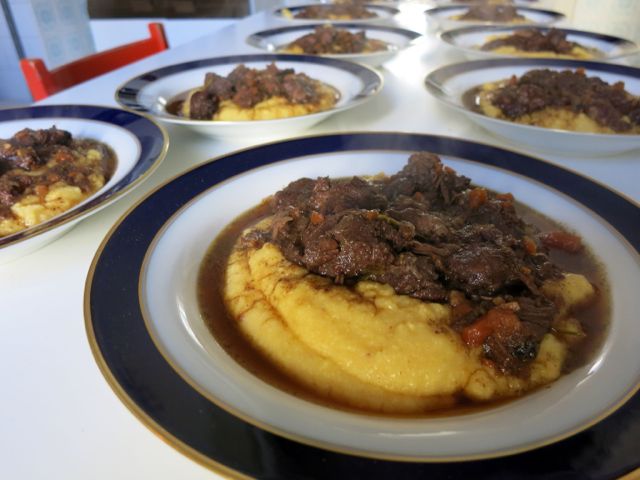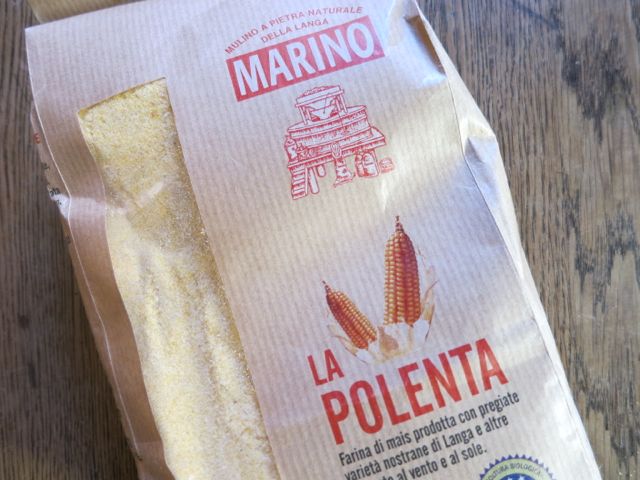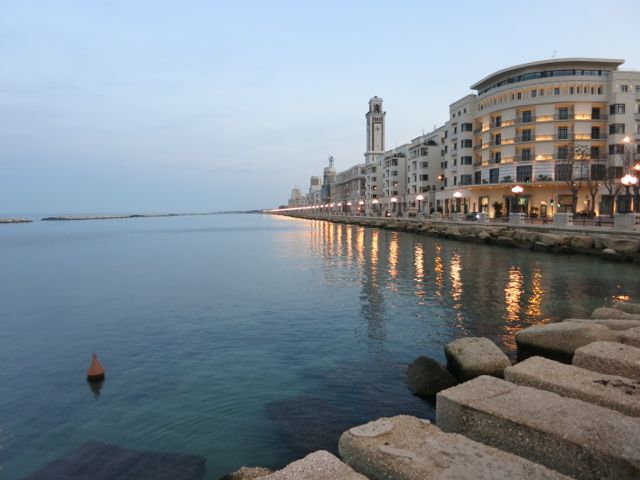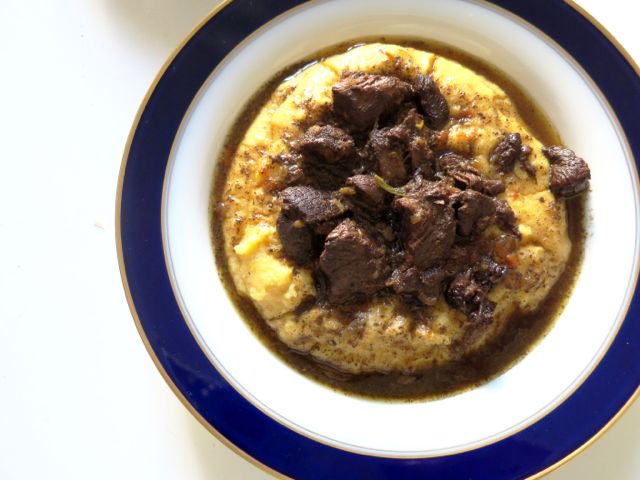
I had a really hard time deciding what to cook for Christmas. We spent the holidays in Bari this year, and while Christmas Eve was all about fish, Christmas day was wide open. In the past we’ve done tortellini in brodo, as well as various stuffed and roasted fowl.
The thing was, I actually didn’t feel like spending the entire day in the kitchen. We stay at Domenico’s mom’s house, and while it’s spacious and comfortable and has a fantastic view of the sea, the kitchen is a bit dysfunctional. I make do. But I’d much rather be outside, walking along the Lungomare.
Then I had the brilliant idea of cooking something in Rome, that I could bring down, ready to go on Christmas day. And since I already had 14 pounds of wild boar meat in the freezer…..
Yes. Domenico came home one day with a leg-o-boar. No. He doesn’t hunt. And no, he didn’t run it over. A contractor from one of his jobs does hunt though, and had more boar than he could handle.
Although I’ve eaten plenty of boar in restaurants all over Umbria and Tuscany, I’d never actually cooked it. And certainly never had to butcher what was essentially a cinghiale ham. It actually wasn’t that difficult once I got going. I cut the meat off the bone, then chopped it into spezzatino sized pieces. Then in several bags it sat in the freezer while I figured out what to do with it.
Unlike pork, chinghiale is a deep, dark, ruby-colored meat. And it is very lean, which means that it can be tough if you don’t cook it correctly. I started browsing around, and realized that most of the recipes are basically variations on marinating, then cooking, in red wine. In other words: boar stew.
And that’s when I realized that this meant that I could also make and eat one of my favorite things in the entire world: polenta. But not any polenta, Mulino Marino polenta. Grown from a heritage variety of corn, this polenta is unlike any other I’ve ever had. It’s ground with the germ, which means it’s a perishable product. That also means that it actually tastes like corn. It’s about as far away from the pre-cooked , instant polenta that is sold everywhere as you can possibly get.
If you’re thinking ‘who wants to stand and stir polenta for an hour?’ I’m here to tell you that you don’t have to. Yes, it does take an hour or more to cook. But you don’t have to stir. At least once the flour is completely poured into the simmering water. It’s a sort of magic recipe that comes straight from the Marino family themselves. And they should know.
So rather than spend the entire day in the kitchen, I made the stew before we left Rome. The two days in the fridge only improved the flavor, like any stew. And with the no-stir polenta method I had a very relaxing day.
And was able to do what I love best in Bari: take a long walk along the Lungomare. 
Wild Boar in Red Wine
(Serves 8-10)
2 kilos / 4 pounds wild boar meat
Marinade:
1 bottle of red wine
3 cloves garlic
1 tablespoon crushed juniper berries
1 tsp salt
1/2 tsp ground black pepper
2 tablespoon olive oil
2 bay leaves
olive oil
salt and pepper
2 carrots
2 stalks celery
1 medium onion
4 cloves garlic
1 bulb fennel
1 cup white wine.
2 cups broth
The boar meat should be cut into 1 1/2 inch cubes. Place in a stainless steel pot and add the rest of the marinade ingredients. Stir and let marinate in refrigerator over night.
To cook:
Take meat out of the marinade, patting the meat dry and reserving the marinade. Season the meat with salt and pepper.
Pour oil into a large saute pan, enough to cover the bottom. Heat to high, and add the meat in one layer. Do not crowd, since you want the meat to brown. You may have to do this in two batches. Cook until browned on all side, turning meat over as it cooks. This should take about 12 minutes or so.
Place meat aside. If there is a lot of oil in the pan, remove some with a spoon, but leave the browned bits of meat on the bottom.
Chop the carrot, celery, onion, garlic and fennel. I just put it all in the food processor and gave it a whiz.
Add the chopped vegetables to the pan that you’ve just used to brown the meat. Cook until the vegetables had softened, stirring and scraping up the browned bits. Add a bit of water if you need to. Let the veggies cook for about 10 minutes or so, then add the white wine, deglazing the pan.
Put meat in a stew pot, and pour the reserved marinade over it. Add the cooked vegetables and broth. Bring to a simmer. Add 1 tsp of salt. Stir and let cook slowly for about 2 and a half hours. Check every so often to make sure there is enough liquid. The meat should be very tender at this point.
If possible, let cool then put in fridge for a day or so, so that the flavors develop. Heat thoroughly before serving.
Polenta
Serves 8-10
The amount of polenta you use is up to you. I usually figure on 100 grams per person, but this means that you will almost certainly have lots of leftover polenta. But since polenta is my favorite thing in the world to eat for breakfast, I figure that’s ok. The main thing you keep in mind is proportions: 1 liter of water for every 200 grams of polenta.
800 grams Polenta*
4 liters water
2 tsp of salt
*It really does make a difference to search out great polenta. I know the instant stuff is easy, but you can’t even begin to compare the taste. Mulino Marino polenta is available at Zingermans and Formaggio Kitchen in the States and in Rome you can buy it at Eataly.
Bring the salted water to boil in a large steel pan with a thick bottom. Just before the water comes to a boil, gradually add the polenta in a steady stream, stirring the entire time. This is the make sure that the polenta doesn’t form lumps.
Bring the heat down to the very lowest possible setting. Put the cover on the pot, and just walk away. If you’re worried, you can check on it every so often and even give it a stir. Mulino Marino suggest on the package that you cook it for about an hour and a half. I find that an hour is plenty.
To serve: Spoon about a cup of cooked polenta into each dish, and top with a few spoon fulls of the stewed boar and the juices. 

Beautiful dish, beautiful walk — what a gorgeous post to end 2012. Happy new year, Elizabeth!
Thank you! Happy New Year to you too!
Elizabeth,
The boar stew with polenta looks amazingly delicious! Best wishes for the New Year. Buon Anno!
Nice dish! looks eye candy!
It sounds like a grand meal, and how nice to have part of it done ahead. I hope that your holiday season has been wonderful, and I send my best wishes to your for a terrific new year!
Thanks Adri, a great new year to you too!
Wonderful recipe! Happy new year to you.
Looks warm and cozy. My grandma used to make “mamaliga” and serve it with feta and sourcream….but wild boar excites me. I’ll have to try it. WISHING YOU A HEALTHY AND HAPPY NEW YEAR.
Your sister from another mother.
Happy New Year!
Oh Yum! This dish is right “up my alley”. On this chilly New Year’s Eve day in SC, I’m wishing I had some of this! 🙂 Buon Anno Elizabeth!
Auguri to you and Arlene from Rome!
Thanks for the recipe Elizabeth and the mouthwatering pics. I don’t expect to be able to find wild boar here in Maryland but I do have access to venison. Seems like it would work just as well don’t you think? And I wonder if anyone has tried Bobs Red Mill Organic Polenta/Corn Grits? Impossible to find Mulino products locally but I thought this might be a good substitute.
And finally, how is Sophie? She hasn’t blogged in quite a while.
Tanti auguri per un felicissimo e sano 2013!
Ric
Yes, I think it work great with venison, let me know how it turns out. And yes, the grits sound like a good idea too.
I also make a no stir polenta, in the oven.
2 Qt. water, 2 C Polenta, 1T salt, 2T butter. in a 3-4 quart le Creuset type pan.
350 deg, uncovered, 1 hour, 20 minutes.
Take out and stir (okay..there is a stir in there) to smooth a bit, return for 10 minutes.
I am making Hoppin’ John tonight, but now you have me hungry for your dish.
If only I could find some cinghiale!
I’m afraid I do not have any wild boar but will try a modified version with beef stew! Thanks!
Is there a reason to pour the dry polenta into simmering water? I stir it into cold water and… no lumps! I can’t tell the difference in taste, can you? I seldom add dry grains to hot water, except rice. Comments?
Now that you mention it, I think I’ve made it in the past starting with cold water too. But I have a feeling that starting with barely simmering water makes things go a bit faster. Because it’s easier to get the plain water up to simmering first – without any polenta in it – then add the polenta once the water is almost boiling.
This looks wonderful. I just made wild boar stew the other day, in fact, in much the same way. (The juniper berries really make the dish!) But tell me, if you would, the polenta does not get scorched at the bottom of the pot without stirring?
Yes, I agree, the juniper makes all the difference. About the polenta: I was scared it was going to scorch too. But it didn’t, not at all. I had the heat very very low, and the pan had a very thick bottom. It just sort of bubbled away, very slowly. And there wasn’t any burnt bits at all on the bottom.
And the bottom of the polenta doesn’t burn?
I have seen no stir recipes before, but they were cooked in the oven, which probably gives you more temperature control and an even cooking.
I however never dared to try them…
I wish I could lay my hands on boar (or any game, really). I can only find premarinated cubes at the supermarket, and that is not good enough.
No, really, it doesn’t burn. There is a very small crust at the bottom of the pan, but that’s it. The trick is to keep it very very low. I”m trying to get more boar, if I do, I’ll put some aside for you.